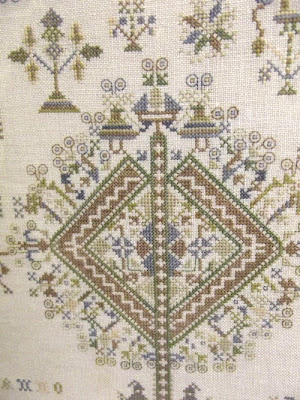Thursday, 13 September 2012
Replica Charts Confuse the Market?
One of the on-going charges levelled against the stitching of replica samplers is whether they, their charters or their stitchers are confusing the market. This sampler appeared in an antiques auction this week with this description: A framed Dutch sampler, dated 1730, depicting the alphabet, animals and plants, 31½" x 18". Estimate:£300 - £400. One cannot take exception to that. It is a Dutch sampler and it is certainly dated 1730. Whether it was stitched in the Netherlands in 1730 though is unlikely.
When we see closer details with their uniformity of stitching, threads and linen weaving, we can be in no doubt that these are modern materials. Given the number of hours that have gone into stitching this sampler and the quality of materials, I would say it is certainly worth the estimate. Whether the purchaser will be aware and will agree is another matter.
But there have always been replicas on the market - I cannot think how much replica furniture there is in antique showrooms and people willingly and knowingly buy it because they like the look. Antique replication goes back as far as Roman times when copies were made of Greek statues - and I am sure replica designs on ceramics go back even further than that.
Subscribe to:
Post Comments (Atom)






I know for certain that it is a replica for I made the same one I think 30 years ago.
ReplyDeleteYes this is a replica! The pattern was recreated in the 70ties and my neighbour made it, it still hangs in her living! When I make a replica I always put my own initials at the bottom with the year so it is always clear that it is not the original!
ReplyDeleteGreetings
Lida